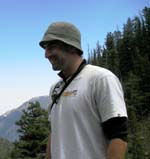Geoscientist 20.12 December 2010/January 2011

Recent articles published in
Geoscientist by Dr Colin MacFadyen of Scottish Natural Heritage (SNH) have raised serious concerns about drill coring for geological samples, both at Sites of Special Scientific Interest (SSSI) and elsewhere (
Geoscientist 20.1 January 2010). Although essential in certain instances for geological research, sampling in this way potentially damages the visual appeal and educational value of important rock outcrops. Certain geological localities should simply not be drilled (and even hand-specimen sampling be carried out thoughtfully and responsibly) out of respect for other scientists and non-academic users of SSSIs.
The conservation of world-class outcrops of significant scientific relevance must remain our ultimate goal, and raising awareness among the general public as well as the scientific community is surely the key to achieving this. Certainly, this would be better than responding, reactively, as Dr MacFadyen has done with his recent articles. I find his language emotive and provocative, and believe that it is simply neither correct nor fair to liken geologists carrying out legitimate scientific sampling to 'vandals'.
Geology is a subject taught in the field. Students will learn and gain the greatest appreciation of their subject in areas where geological diversity is coupled with good quality exposure in outcrop. In the UK, we also have that unique history, in that many of geology’s landmark scientific ideas originated here, often at outcrop (witness Hutton’s unconformity, at Siccar Point). It is also worth remembering that the number of geologists (students as well as more senior academics and visiting researchers from abroad) carrying out fieldwork and mapping in ‘classic’ British localities is increasing at a faster rate than ever before.
For all these reasons, greater emphasis is needed on conservation issues, by raising awareness and providing clear information on-site at SSSIs. Provision by SNH of on-site instruction and educational materials would represent a more proactive and, I believe, effectively preventative approach to dealing with greater numbers of SSSI users (scientists and the general public alike) in Scotland in the future. Signs or boards, written simply and without scientific jargon, delineating SSSI areas/boundaries and the reasons for their designation, would be appropriate.
This approach is more in line with international conservation strategies, particularly in the USA, where National Parks and State Forests typically provide very clear on-site information about what is allowed and what is not. This type of management exists in certain locations in Scotland (e.g., Arthur’s Seat, Knockan Crag and Clashach Quarry), where interpretive materials are in place for visitors and tourists. Unfortunately, hundreds of SSSIs throughout Scotland and the rest of the UK do not, and for the first-time user, finding online information on SSSI designations is a seriously non-trivial process.
If a site, geological or otherwise, is worth assigning SSSI status, then surely it is worth providing accessible and scientifically informative on-site signage?
* Lecturer in Igneous and Metamorphic Petrology School of Physical and Geographical Sciences, Keele University